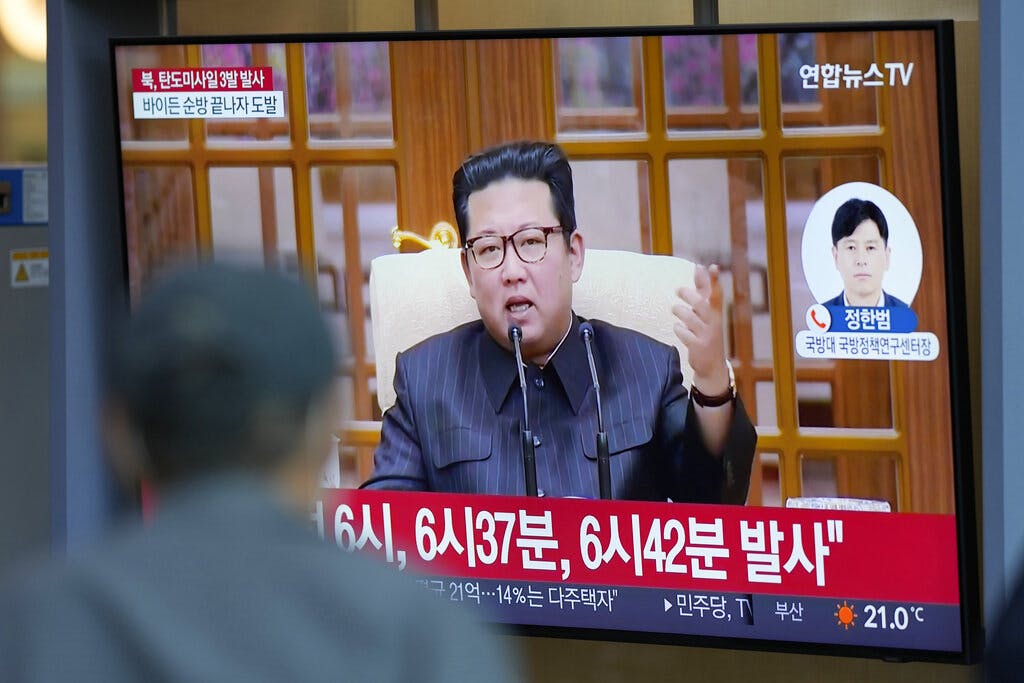Memorial Day Message: The Vigil at the Korean DMZ Growing More Tense
North Korean bellicosity means that the danger of ‘incidents’ intended to frighten the South has seldom been higher.

GOSEONG, South Korea — With Memorial Day approaching in the United States, which lost 36,516 troops in the Korean War, a convoy of South Korean K1 tanks lumbers up the east coast highway toward the southern side of the demilitarized zone dividing North from South Korea. Inside the zone, at the northernmost observation point facing distant North Korean guard posts, an officer from the South’s 22nd division talks about our common foe.
The enemy is, he points out, lurking on tree-covered slopes below the North’s Kumgang or Diamond Mountain, 10,000 or so rocky peaks that once had been a tourist attraction portending warm relations between the two Koreas. No more. These days, the South Koreans have to expect the unexpected, ever on alert for a sudden surge, an explosion or foray of infiltrators from above the line.
This is the watch that is kept in South Korea while North Korea’s leader, Kim Jong-un, orders more missile tests and decides when’s the propitious moment for staging the North’s seventh nuclear test. With South Korea’s new president, Yook Suk-yeol, vowing no more “appeasement” of Mr. Kim’s designs on the South, North Korean bellicosity means that the danger of “incidents” intended to frighten the South has seldom been higher.
It’s among these craggy slopes, extending south from North Korea, that North Korean forces waged some of the toughest battles of the Korean War. Over the years, the North Koreans have been testing the South’s defenses of a portion of the frontier that once was part of North Korea but remained in South Korean hands when the Korean War armistice was signed in July 1953.
The North obviously would like someday to recover its lost real estate. “We need to expect a kinetic response from North Korea,” a retired South Korean lieutenant general, Chun In-bum, who once commanded a battalion of South Korean soldiers on a remote mountaintop a few miles to the west of the northernmost South Korean outpost, says.
General Chun seems just as concerned about the dangers of a North Korean attack as he was when I first met him years ago when he was a lieutenant colonel atop Hill 911 — the 911 signifying its altitude in meters above the ocean, shimmering on a sunny day a few hundred meters to the east.
“We know they’re there, and we have to be ready for anything,” General Chun says, warning that the South Korean side may not be as equipped as needed if the North Koreans decide to invade. General Chun reckons that a North Korean attack, in the form of acts of terrorism or pinpoint targeting of South Korean defenses — as in the shelling of an isolated South Korean island in 2010 — presents a more immediate danger than that of the North firing missiles, much less nukes.
A South Korean officer, briefing visitors at the 22nd Division observation point, gestures toward gashes in the forests covering the slopes where the North Koreans are waiting, watching for chinks in the South Korean armor. The North Koreans, he suggests, might be especially primed for attacking here in hopes of recovering territory above the 38th parallel that they lost when the shooting stopped.
The 38th parallel marked the line drawn on a National Geographic map of the peninsula that an Army officer in the Pentagon, Dean Rusk, later secretary of state, decided would be a nice division between Soviet and American zones after the Japanese surrender in August 1945. Instead, failure to insist on a unified Korean peninsula, under one government, led to the invasion of the South in June 1950 that was ordered by Kim Jong-un’s grandfather, Kim Il-sung, who ruled the North for nearly half a century.
Now, despite North Korea’s frequent missile tests and signs that Kim Jong-un is preparing for the North’s first underground nuclear test since its sixth and most recent test in September 2017, low-level warfare along the DMZ is a far more urgent danger than that of attack by a North Korean missile with a miniature nuclear warhead fixed to its nose.
No one believes that North Korea is going to mount a strike that would plunge the peninsula into the second Korean War and risk Mr. Kim losing his positions as general secretary of the ruling Workers’ Party, president of the state commission, and, of course, marshal and commander of the Korean People’s Army’s 1.2 million troops, twice the South’s 600,000 troops.
The chief American envoy on North Korea after President Trump met Mr. Kim in their summit in Singapore in June 2018, Stephen Biegun, painted a near-hopeless picture of the chances for reconciliation with the North. Dialogue broke down after the failure of Mr. Trump’s second summit with Mr. Kim in June 2019.
Mr. Biegun, at a gathering here hosted by Korea Risk Group, which analyzes and tracks North Korea from Seoul, was not optimistic about talks resuming with American and South Korean troops poised to resume joint military exercises, suspended by Mr. Trump after the Singapore summit.
The best Mr. Biegun could hope for was that war between the two Koreas would not resume even if peace remains elusive as ever. Recalling that war games had included “decapitation” exercises for annihilating the North Korean leader, he reminded his audience of a maxim often attributed to Nicolo Machiavelli, “If you’re going to kill the king, don’t miss.”
Actually, Machiavelli in the early 16th century wrote, “The injury that is to be done to a man ought to be of such a kind that one does not stand in fear of revenge.” In the meantime, General Chun laments that South Korea’s military budget, while covering some big-ticket items, hardly pays for all the basic infantry weapons and ammunition needed to repel the North Koreans. “Waging war is difficult in these mountains,” he said. “We need to do much more to stop them.”

